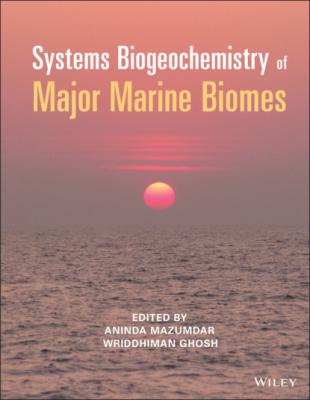Systems Biogeochemistry of Major Marine Biomes. Группа авторов
Чтение книги онлайн.
Читать онлайн книгу Systems Biogeochemistry of Major Marine Biomes - Группа авторов страница 24
 V.V.S.S., Bhaskar, T.U., Kumar, J.P. et al. (2020). Potential mechanisms responsible for occurrence of core oxygen minimum zone in the north‐eastern Arabian Sea. Deep Sea Research Part I: Oceanographic Research Papers 165: 103393. https://doi.org/10.1016/j.dsr.2020.103393
V.V.S.S., Bhaskar, T.U., Kumar, J.P. et al. (2020). Potential mechanisms responsible for occurrence of core oxygen minimum zone in the north‐eastern Arabian Sea. Deep Sea Research Part I: Oceanographic Research Papers 165: 103393. https://doi.org/10.1016/j.dsr.2020.103393161 Schenau, S.J., Passier, H.F., Reichart, G.J. et al. (2002). Sedimentary pyrite formation in the Arabian Sea. Marine Geology 185 (3–4): 393–402. https://doi.org/10.1016/S0025‐3227 (02)00183‐4
162 Schimmelmann, A., Lange, C.B., Schieber, J. et al. (2016). Varves in marine sediments: a review. Earth‐Science Reviews 159: 215–246. https://doi.org/10.1016/j.earscirev.2016.04.009
163 Schmaljohann, R., Drews, M., Walter, S. et al. (2001). Oxygen‐minimum zone sediments in the northeastern Arabian Sea off Pakistan: a habitat for the bacterium Thioploca. Marine Ecology Progress Series 211: 27–42. https://doi.org/10.3354/meps211027
164 Schmidt, H., Czeschel, R. and Visbeck, M. (2020a). Seasonal variability of the circulation in the Arabian Sea at intermediate depth and its link to the Oxygen Minimum Zone. Ocean Science Discussions 1–31. https://doi.org/10.5194/os‐2020‐9.
165 Schmidt, H., Czeschel, R. and Visbeck, M. (2020b). Seasonal variability of the Arabian Sea intermediate circulation and its impact on seasonal changes of the upper oxygen minimum zone. Ocean Science 16 (6): 1459–1474. https://doi.org/10.5194/os‐16‐1459‐2020
166 Schmidtko, S., Stramma, L. and Visbeck, M. (2017). Decline in global oceanic oxygen content during the past five decades. Nature 542 (7641): 335–339. https://doi.org/10.1038/nature21399
167 Schott, F.A. and McCrearyJr, J.P. (2001). The monsoon circulation of the Indian Ocean. Progress in Oceanography 51 (1): 1–123. https://doi.org/10.1016/S0079‐6611 (01)00083‐0
168 Schulz, H.N., Brinkhoff, T., Ferdelman, T.G. et al. (1999). Dense populations of a giant sulfur bacterium in Namibian shelf sediments. Science 284 (5413): 493–495. https://doi.org/10.1126/science.284.5413.493
169 Schunck, H., Lavik, G., Desai, D.K. et al. (2013). Giant hydrogen sulfide plume in the oxygen minimum zone off Peru supports chemolithoautotrophy. PloS One 8 (8): p.e68661. https://doi.org/10.1371/journal. pone.0068661
170 Seitaj, D., Schauer, R., Sulu‐Gambari, F. et al. (2015). Cable bacteria generate a firewall against euxinia in seasonally hypoxic basins. Proceedings of the National Academy of Sciences 112 (43): 13278–13283. https://doi.org/10.1073/pnas.1510152112
171 Seiter, K., Hensen, C., Schröter, J. et al. (2004). Organic carbon content in surface sediments – defining regional provinces. Deep‐Sea Research Part I 51: 2001–2026. https://doi.org/10.1016/j.dsr.2004.06.014
172 Seiter, K., Hensen, C. and Zabel, M. (2005). Benthic carbon mineralization on a global scale. Global Biogeochemical Cycles 19: 1–26. https://doi.org/10.1029/2004GB002225
173 Sellanes, J. and Neira, C. (2006). ENSO as a natural experiment to understand environmental control of meiofaunal community structure. Marine Ecology 27 (1): 31–43. https://doi.org/10.1111/j.1439‐0485.2005.0006
174 Sengupta, D., Bharath Raj, G.N. and Shenoi, S.S.C. (2006). Surface freshwater from Bay of Bengal runoff and Indonesian throughflow in the tropical Indian Ocean. Geophysical Research Letters 33 (22). https://doi.org/10.1029/2006GL027573
175 Shankar, D., Shenoi, S.S.C., Nayak, R.K., et al. (2005). Hydrography of the eastern Arabian Sea during summer monsoon 2002. Journal of Earth System Science 114 (5): 459–474. https://doi.org/10.1029/2006GL027573
176 Sharma, G.S. (1978). Upwelling off the southwest coast of India. Indian Journal of Marine Sciences 7 (4): 209–218.
177 Shenoi, S.S.C., Shankar, D., Michael, G.S., et al. (2005). Hydrography and water masses in the southeastern Arabian Sea during March–June 2003. Journal of Earth System Science 114 (5): 475–491. https://doi.org/10.1007/BF02702024
178 Shenoy, D.M., Suresh, I., Uskaikar, H., et al. (2020). Variability of dissolved oxygen in the Arabian Sea Oxygen Minimum Zone and its driving mechanisms. Journal of Marine Systems 204: 103310. https://doi.org/10.1016/j.jmarsys.2020.103310
179 Shetye, S.R., Gouveia, A.D., Shenoi, S.S.C. et al. (1990). Hydrography and circulation off the west coast of India during the southwest monsoon 1987. Journal of Marine Research 48 (2): 359–378. https://doi.org/10.1357/002224090784988809
180 Sinninghe Damsté, J.S. and De Leeuw, J.W. (1990). Organic sulfur compounds and other biomarkers as indicators of palaeosalinity. In: Geochemistry of Sulfur in Fossil Fuels. ACS Symposium Series, Vol. 429, 417–443. Washington DC: American Chemical Society. https://doi.org/10.1021/bk‐1990‐042h024
181 Sohm, J.A., Webb, E.A. and Capone, D.G. (2011). Emerging patterns of marine nitrogen fixation. Nature Reviews Microbiology 9 (7): 499–508. https://doi.org/10.1038/nrmicro2594
182 Somayajulu, B.L.K., Sarin, M.M. and Ramesh, R. (1996). Denitrification in the eastern Arabian Sea: evaluation of the role of continental margins using Ra isotopes. Deep Sea Research Part II: Topical Studies in Oceanography 43 (1): 111–117. https://doi.org/10.1016/0967‐0645 (95)00079‐8
183 Sommer, S., Gier, J., Treude, T. et al. (2016). Depletion of oxygen, nitrate and nitrite in the Peruvian oxygen minimum zone cause an imbalance of benthic nitrogen fluxes. Deep Sea Research Part I: Oceanographic Research Papers 112: 113–122. https://doi.org/10.1016/j.dsr.2016.03.001
184 Stevens, H. and Ulloa, O. (2008). Bacterial diversity in the oxygen minimum zone of the eastern tropical South Pacific. Environmental Microbiology 10 (5): 1244–1259. https://doi.org/10.1111/j.1462‐2920.2007.0153
185 Stramma, L., Fischer, J. and Schott, F. (1996). The flow field off southwest India at 8N during the southwest monsoon of August 1993. Journal of Marine Research 54 (1): 55–72. https://doi.org/10.1357/0022240963213448
186 Stramma, L.,